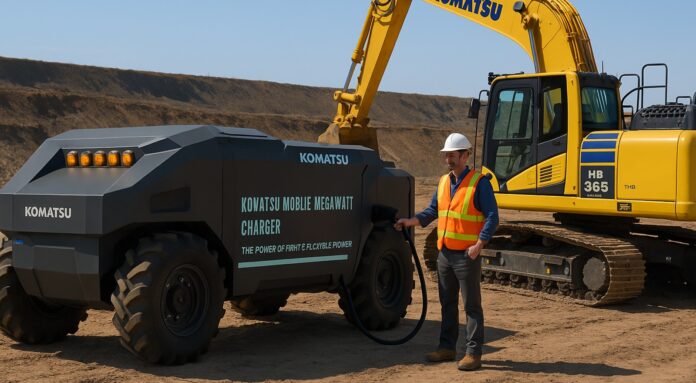There’s no question that electric construction equipment is safer, more precise, and generally better than the diesel equipment it’s replacing, but getting power to that equipment remains a logistical challenge that hasn’t been solved for. With this new mobile Megawatt charging station, however, Komatsu think they’ve found a solution — with up to 6 MW of power!
Developed by Tesla co-founder Ian Wright, Dimaag, and Japanese equipment giant Komatsu, the groundbreaking Mobile Megawatt Charging System (MWCS) promises to bring electricity where it’s needed, anywhere on the job site, then quickly dispense enough energy to get the electric machines under its care back up and running.
And, with Megawatt power delivery on tap, the new Komatsu-Dimaag MWCS can power up equipment assets between shift changes — if it even takes that long!
Komatsu Dimaag mobile charger

The MWCS boasts a compact, high-efficiency DC-DC converter and a long-life, high-discharge-rate Battery Energy Storage System (BESS) on board that can be connected to a DC fast charger itself, or get “trickle charged” between shifts. Both the battery and its control systems make use of an advanced thermal management solution that Komatsu and Dimaag say optimizes both safety and battery life during high-power delivery.
What’s more, that charging capability won’t stop at just one Megawatt. The system is designed to be scalable up to six (6) Megawatts — making it suitable to juice up even the biggest EVs and, frankly, strongly implying that they’ve already got a buyer.
To make sure the MWCS can get all that power where it needs to, wherever it needs to, the machine is equipped with with stout, construction-grade AT tires, 4-wheel drive, and 4-wheel steering to navigate tight surroundings and rough terrains that other solutions wouldn’t be able to get to. And, while it isn’t mentioned in the press release, there’s a common sense idea here that you could, in a pinch, use the MWCS to tow less capable vehicles out of the mud and snow, if needed.
For their part, it seems like the people at Dimaag are pretty happy with the results. “Dimaag is excited to collaborate with Komatsu, introducing our advanced ESS and DC-DC architecture to revolutionize electrification in construction,” stated Ian Wright, VP Engineering at Dimaag. “Off-road vehicle electrification demands practical solutions that not only meet but exceed the performance of equivalent large diesel engine vehicles, while also providing substantial Total Cost of Ownership (TCO) savings. Dimaag’s electrification and high-power megawatt charging systems are designed to achieve this.”
The prototype MWCS shown, above, features a 295 kWh battery pack and an MCS connector delivering up to 1,500 amps and 1,000 volts of power. Komatsu envisions a scenario wherein the mobile charger makes its rounds on the job site charging up equipment and heading back to grid power (if available) to charge itself.
The MWCS made its debut at the bauma construction show earlier this year. Real-world trials are expected to begin this year.
Electrek’s Take

Conceptually similar to the mobile power platform being developed by American firm Dannar, this new mobile Megawatt charging unit has some heavy-hitting names behind it that make it impossible to ignore. Combine that with Komatsu’s ever-increasing push towards full electrification (the two machines shown, above, are all-new in the last 60 days, with more to come) and it really feels like the MWCS is going to be A Real Thing™️somewhat sooner than later.
Stay tuned.
SOURCES | IMAGES: Komatsu, Dimaag, via EIN Presswire.

Your personalized solar quotes are easy to compare online and you’ll get access to unbiased Energy Advisors to help you every step of the way. The best part? No one will call you until after you’ve elected to move forward. Get started, hassle-free, by clicking here.
FTC: We use income earning auto affiliate links. More.


